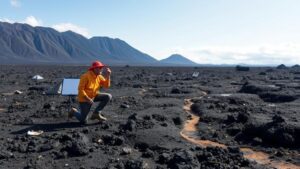Techniques for Spotting Subtle Landscape Features That Indicate Caches
Techniques for Spotting Subtle Landscape Features That Indicate Caches
Identifying subtle landscape features that may indicate the presence of caches is a critical skill in fields such as archaeology, treasure hunting, and historical research. These features often blend seamlessly into the environment, making them difficult to spot and requiring a keen eye and a well-informed approach to detection. This article outlines various techniques that can enhance the ability to spot these indicative landscape features, integrating practical applications and theoretical insights.
Understanding Landscape Features
Landscape features may include changes in vegetation patterns, soil disturbances, or unnatural formations in the natural landscape. Familiarizing oneself with the typical characteristics of a specific area is essential for recognizing deviations that may signify hidden caches. For example, an area with a dense canopy might hide depressions or contours typically unnoticeable from a cursory glance.
Research indicates that even in dense forest ecosystems, changes in flora and fauna can reveal significant anomalies. A study conducted by the National Park Service found that landscape variations can often align with historical human activity, indicating potential cache locations beneath the surface.
Techniques for Detection
To effectively spot subtle landscape features, the following techniques are particularly beneficial:
- Remote Sensing Technologies: Utilizing GIS (Geographic Information Systems) and aerial photography can highlight changes in land cover that are indicative of human modification. For example, heat mapping can reveal buried structures during aerial surveillance.
- Soil Analysis: Conducting soil tests and examining for inconsistencies can indicate past human presence. Disturbed soil patterns, such as color changes or differing organic material, may point to hidden caches.
- Geophysical Surveys: Techniques such as ground-penetrating radar (GPR) and magnetic surveys can uncover subsurface anomalies without invasive digging. Such methods are essential in archaeological digs for pinpointing structures or materials buried underground.
Visual Observation Techniques
Not all techniques require sophisticated technology; keen visual observation plays a significant role in spotting subtle landscape features. following strategies can be implemented:
- Analyzing Vegetation: Unusual plant growth or die-off can indicate disturbances beneath the surface. For example, a patch of unusually lush vegetation can be a sign of buried organic material.
- Contour Analysis: Understanding the natural contours of the land can help identify anomalies. A slight mound or dip that does not conform to surrounding topography may indicate a cache.
- Water Flow Patterns: Observing how water flows across a landscape can reveal disturbances. Natural changes in drainage can suggest the presence of underground structures or caches.
Case Studies and Real-World Applications
Numerous case studies illustrate the successful application of these techniques. For example, archaeological excavation sites in the Mediterranean have employed soil analysis and remote sensing technologies to identify ancient Roman cache sites buried under layers of sediment, leading to significant archaeological finds.
Another notable case is the discovery of cache sites associated with the American Civil War. In Virginia, researchers utilized GPR technology to reveal hidden military stores, which were later excavated based on the findings from the geophysical survey.
Challenges and Limitations
While these techniques are invaluable, they are not without their challenges. Factors such as soil composition variability, weather conditions, and human activity can alter or obscure the subtle landscape features of interest. Also, remote sensing equipment can be costly and may require specialized training to operate effectively.
Actionable Takeaways
To wrap up, the techniques for spotting subtle landscape features indicative of caches combine scientific analysis with astute observational skills. The importance of understanding local geography, employing technology judiciously, and being aware of environmental factors cannot be overstated. Those interested in enhancing their cache-spotting abilities should consider the following actionable steps:
- Engage in local geological surveys to better understand typical landscape features in your area.
- Invest in training to familiarize yourself with remote sensing technologies and geophysical survey methods.
- Practical fieldwork, such as participating in archaeological digs or geological studies, can provide hands-on experience in identifying landscape features linked to caches.
By applying these techniques and approaches, individuals can significantly improve their skills in spotting subtle landscape features that indicate caches, opening the door to new discoveries.



